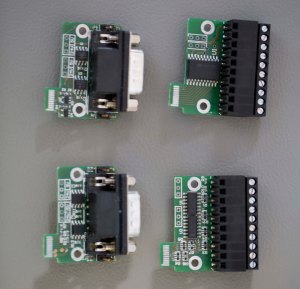RasPiComm+
Posted by on April 10, 2013
Here is a quick update on the RasPiComm+ status. We are currently working hard on the Raspberry Pi drivers and hope to get the RasPiComm+ out there in Q3.
The board itself is a 56x74mm 4-layer board, most components are mounted on the bottom. The top-side only features 4 edge-board connectors for the modules, power LEDs and two JTAG debugging/programming headers for the Cortex M3/M4F and the Altera MAX V CLPD.
We currently have 6 RasPiComm+ modules which we are testing:
- 8 Input (with adjustable reference voltage, can be jumpered to 5V or 24V or fed from outside)
- 8 Outputs (5V or 24V or fed from outside)
- GSM module
- RS-485 (two RS-485 on one board)
- CAN (two CAN bus ports on one board, you’ll need the ARM Cortex-M4 option to use both simultaneously)
- 16 isolated I/O (using th iC Haus iC-JX)
The firmware of the Cortex M3/M4F (both can be populated) will provide a bridge from the extension boards to the Raspberry Pi and interface with the drivers. The ARM microcontroller can be programmed from the Raspberry Pi for power users. It will come with a fully functional firmware and does not need to be changed though. If you want do do realtime or high relieability stuff you can do this by programming the ARM microcontroller.
The CPLD is also programmable via the Raspberry Pi, so changing configurations for different extension modules is easy.
The big metal box on the bottom side is an isolated DC/DC converter. This will be optional and powers both the RasPiComm+ and the Raspberry Pi from a 24V power supply. The battery holder is for the real-time clock backup battery for which we will also add driver support, so that the Raspberry Pi can get the current date and time.
The driver is very elegant I think. You can dynamically load and unload driver modules and they create an interface (for example /dev/ttyRPC0) to the specified module in case the module is a serial module (this applies to the GSM, RS-485 and the CAN module). This is already working quite well, we successfully sent SMS messages from the Raspberry Pi.
For the I/O modules we are looking into a driver interface similar to the Raspberry Pi GPIOs, but this is still work in progress, if you have suggestions what the best way is to implement I/Os leave a message 🙂
I will post separate articles about the RPCP extension boards to explain them in detail.
And if you have any other ideas how to make the RasPiComm+ even better let me know!



Keep on going like this … I cant wait to get one of these modules … Alex
Looks like the plus could get pretty expensive- and doesn’t seem to provide that many benefits over e.g. quick2wire? One of the biggest limitations of the Pi though- missing analog inputs/outputs- is not addressed. I guess I’ll just keep an arduino as inexpensive extension board around.
The RasPiCommPlus is designed with price in mind, it will be around the same price as the RasPiComm. Also we have 4 analog inputs wired to the edge-card connectors. We are planning a ADC extension board, but we started with digital stuff. I think quick2wire is completely different. With the RasPiComm Plus you can design real-time applications in the microcontroller, you have CAN bus, RS-485, isolated I/Os (up to 64 if you only need I/Os) and a GSM modem for sending and receiving SMS or sending data via GPRS, all of that with driver support. But if your project can be done with quick2wire there is definately no reason for a RasPiComm Plus.
GPIO 4 can be used for 1wire-bus. Would it still be possible to use GPIO 4 when the RasPiComm+ is connected or will you add a 1wire module in the future?
1-wire is currently in development 🙂
Hi Daniel,
I follow your development of the RasPiComm+ with great interest. Do you have an updated ETA on the release date? What do you expect the pricepoint to be?
Best Regards
Christian
The project got pushed back a bit, we are still working on the driver software, I would say it should be available at the beginning of 2014.
I can’t tell you the final price yet, still depends on the quantities we are able to make.
I will post here on the blog when I have any news!
Are there now or will there be any US vendors?
There will be US vendors. Our predecessor board, the RasPiComm, is available via http://www.alliedelec.com. I’m very confident that the RasPiComm+ will be available too. Also, http://www.modmypi.com will have our current board on stock soon, so there is a good chance that they will also have the RasPiComm+ when it’s available, and they offer good shipping prices worldwide.
Hi!
Is the RasPiComm+ out yet!!?
No but soon. See the current blogpost: https://amesberger.wordpress.com/2014/10/30/raspicommplus